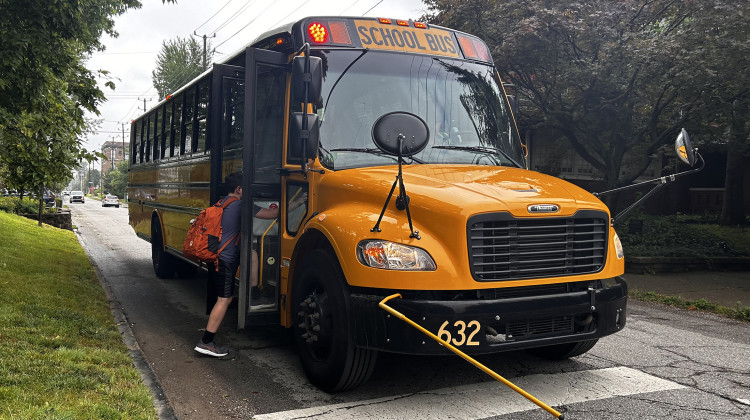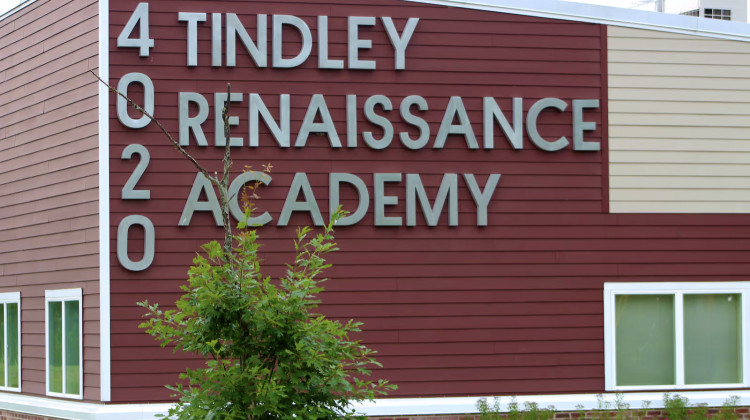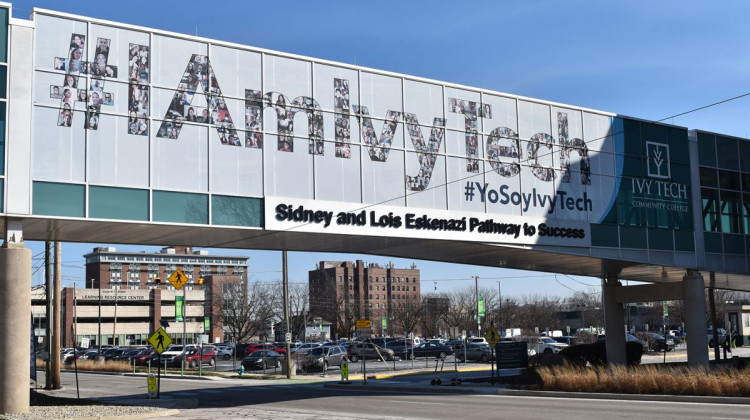
Bethel Park Elementary weaves social identity into its lessons so students can explore their histories and cultures — and that of others, too.
Maxine Wallace for ChalkbeatAt Bethel Park Elementary in Indianapolis, a fourth- and fifth-grade book club pauses in a read-aloud to discuss this line in “The Hate U Give”:
Funny how it works with white kids though. It’s dope to be black until it’s hard to be black.
“Black people can’t really do stuff like white people can,” a student says.
Eight students sit around a table, almost all of them Black — a reflection of the older grades at the small elementary school. The student grows shy when the teacher asks him to elaborate. A classmate chimes in: “Black people don’t have as much privilege as white people sometimes.”
“Ah, privilege,” teacher Treasure Jones says, underscoring a term that some politicians would rather she didn’t.
Five miles away from the school, lawmakers at the Indiana Statehouse spent months this year debating censoring lessons like these, which deal with racial identity and racism, deeming them “divisive.” Republican leaders, falling in line with the conservative movement across the country, didn’t want teachers to discuss Black Lives Matter, institutional racism, white privilege, or unconscious bias.
Those politicians were fighting on behalf of a vocal contingent of parents in mostly white suburban districts who protest against diversity, equity, and inclusion efforts out of concern that they unfairly malign white people. They often say they’re trying to ban critical race theory, an academic concept taught in law schools that examines how racism is embedded in society and government.
But for racially diverse schools such as Bethel Park, the legislative battles threaten to interrupt years of work to better serve marginalized students. Proposed laws sought to prohibit racial equity training for teachers, which highlights how systemic racism persists and shows teachers how to recognize their own biases. Educators devoted to this work fear that silencing conversations on race could whitewash lessons and alienate students of color.
The stakes are high: Many Indianapolis schools believe more inclusive lessons and intensive training are vital to closing academic gaps between students of different races. Nearly three-quarters of students across Indianapolis’ 11 districts and dozens of charter schools are Black, Latino, or other students of color.
“We’re not in a position to have leaders or educators opt out of culturally responsive practices,” said Erica Buchanan-Rivera, Director of Equity and Inclusion for Washington Township Schools. “We own that we have disparities to address.”
Ultimately, Indiana lawmakers dropped this year’s attempt to pass curriculum restrictions after a series of Republican stumbles. But many educators are bracing for another legislative battle next year and expect to see the issue rear up during upcoming school board elections.
School officials and education advocates say that puts the racial equity work in Indianapolis schools front and center, underscoring the need for policymakers to better understand the priorities, progress, and challenges at city schools.
“When we look at who is centered in these conversations around this anti-CRT legislation, it’s white children,” said Tambra Jackson, dean of education at IUPUI and professor of urban education. “We are not talking about the most vulnerable children.”
In Indianapolis schools, the racial equity movement has undergone a decades-long evolution.
Patricia Payne remembers walking into her first Indianapolis Public Schools classroom 60 years ago, a Black teacher for Black students in a segregated school system.
“The first thing I noticed was the textbooks and the resources did not reflect the students except the chapter on slavery,” said Payne, now IPS’ racial equity director.
Over the years, the 31,000-student district made strides such as resolving to teach Black history, creating a multicultural office, and adding racial equity training for educators.
The racial gaps in student outcomes illuminate the need for schools to make sure their teaching practices aren’t just equal, but equitable — meaning they help all students reach the same levels of success.
In Indiana, just 8% of Black students pass both math and English standardized tests. They are less likely to graduate than their white peers, less likely to have access to advanced courses, and more likely to face suspensions.
In 2020, IPS made a big statement. The district, which serves about 80% students of color, publicly acknowledged its role in perpetuating systemic inequities in the past — and pledged to change practices that contribute to racial disparities.
IPS called it Board Policy 1619, in a nod to The New York Times’ 1619 Project, which reframes U.S. history by centering the legacy of American slavery, beginning the year enslaved Africans first arrived in the English colony.
At the same time, the board put forward a forceful Black Lives Matter statement: “To believe that Black lives matter — and to put that belief into action,” it reads in part, “means to commit ourselves to a radical refusal to give up on any student, to hand them over to a criminal justice system that doesn’t share our values, or return them to communities that lack the resources to support the realization of their fullest potential.”
What does that look like in schools?
School officials have to consider how each decision — large or small — can affect children differently, advocates say. Where are magnet programs located? Who’s affected by transportation cuts? Which students are affected the most by out-of-school suspensions?
Buchanan-Rivera, Washington Township’s equity director, looks to teachers and leaders to reach these goals. The northside district has a steep hill to climb: Out of the 11 Indianapolis districts, Washington Township Schools faces the widest disparity in test scores between Black and white students — a 44 percentage point gap in ILEARN passing rates.
Educators have to be willing to overhaul what they’re doing and question flaws in school systems. Buchanan-Rivera calls it “mirror work,” because educators must “look into the mirror to reflect on their own practices and how they are showing up for children.”
“We all know it’s easier to point the finger to societal factors,” she said, “rather than to talk about the harmful or ineffective practices occurring within schools.”
IPS and Washington Township were two of the districts that spoke out against Indiana’s anti-CRT legislation.
Lawmakers’ attempt to ban discussions on racism seemed like “a bad solution in search of a non-existent problem in our state and community,” IPS board members said in a statement.
Washington Township officials said they “stand against censoring the truth of our history and the lived experiences of students.”
Among the effects of the proposed legislation was that it would have stopped districts from training teachers to recognize what racism looks like in schools, including how trying to be “color-blind” ignores the past and present realities of racial oppression.
“In our mind’s eye, if you do not teach children the truth, then they will not be able to make sense of their world,” Payne said. “And we’re not just talking about teaching the truth to Black and brown children, we’re talking about teaching the truth to all children.”
IPS fell under conservative crosshairs last year when a former teacher said schools lie about not teaching critical race theory because it’s embedded in teaching approaches. IPS fired the teacher in January for several violations of ethics and conduct policies.
Still, unlike in suburban districts, where parents have protested at school board meetings against racial equity efforts they consider divisive, IPS sees broad support among families for creating more inclusive classrooms.
If anything, much of the pushback IPS deals with comes from people advocating for bolder steps to address inequities.
IPS parents, for example, have been flocking board meetings to push for better policies for Black and Latino students. Last month, a handful of parents asked board members for data on which schools serve Black and Latino students best, to take into consideration as the district plans a reorganization that could close schools.
“It’s on the district to make a model and to grow our schools that work better for our Black and brown children,” said Shawanda Tyson, a parent advocate with Stand for Children Indiana. One of Tyson’s children attended a school that is closing this year due to poor academic results, and another is thriving at a charter school outside of IPS.
She’s advocated for racial equity training, among other systemic changes. Parents, Tyson believes, all want the same thing: “We just want children to have the same high-quality education, and it shouldn’t come at the cost of where we live or income or money.”
While this year’s legislative debates often focused on history lessons, teachers also worry about being silenced on current racial injustices — especially when their students are hungry for those conversations.
At Bethel Park Elementary, students have been talking about gun violence and police brutality while studying “The Hate U Give.”
The novel by Angie Thomas, which centers on a police shooting of an unarmed Black boy, was briefly banned by a Texas school district. Police also challenged the book in a South Carolina district.
Bethel Park formed a lunchtime book club with 10 fourth- and fifth-graders whose parents gave permission for them to read “The Hate U Give.” At the 200-student charter school, everyone in those grades is a student of color, and 85% of the overall student body is Black, Latino, multiracial, or Native American.
Bethel Park educators believe students will be more engaged and better positioned to succeed when they feel heard and see themselves represented in the curriculum. The school weaves social identity into its lessons so students can explore their histories and cultures — and that of others, too.
“We come from a variety of different places, and if we’re going to teach one perspective all the time, many of my children are not going to be able to see themselves in the curriculum,” Jones said. “They’re not going to be able to see themselves as writers. They’re not going to be able to see themselves as teachers, even, and all these other beautiful, diverse careers.”
One day this spring, the book club students brought their lunches from the cafeteria to a conference room, opening their books and skipping over the curse words as they read aloud.
At the beginning of the book, Starr, the Black teenage main character, leaves a party when gunshots go off. A police officer pulls over the car she’s riding in, barking orders at her best friend, Khalil.
When Khalil checks on Starr, the officer opens fire.
Pow! Pow! Pow!
In the book, Khalil falls to the ground.
In the Bethel Park conference room, the book club goes silent.
One student says Khalil should have followed the officer’s instructions. Another says the officer could have said, “Put your hands up” and didn’t need to shoot Khalil. They talk about how the officer probably felt afraid, then wondered where that fear came from.
Jones invited a local police officer to talk to students and answer their questions. She tells the students about how the killing of Tamir Rice, a 12-year-old Black boy playing with a toy gun who was shot by police in 2014, shook her and shaped the way she went through her college studies.
Before the lunch group ends, Jones asks how they feel. A couple of students say they feel scared and sad, that something like this could happen to them or their families.
“If you are scared of how society is right now, or how we live right now, you have a voice, right?” Jones said. “And you can use that to make…”
“A better place, like Martin Luther King!” one student chimes in.
“We just need to figure out how to do that, right?” Jones says. “And we have to build relationships so that people will be inclined to listen to us.”
Kae Petrin contributed to this story.
Stephanie Wang covers education in Indiana, including pre-K, K-12 schools, and higher education. Contact Stephanie at swang@chalkbeat.org.
Chalkbeat is a nonprofit news site covering educational change in public schools.
 DONATE
DONATE






 Support WFYI. We can't do it without you.
Support WFYI. We can't do it without you.